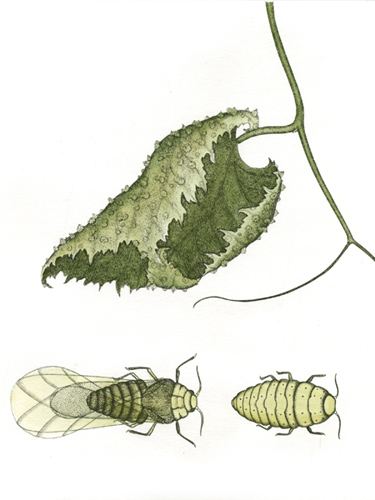(Part 2)
The root aphids seem to thrive most effectively in rock wool, followed by coco and hydroton. Soil and soiless mixes generally offer a slightly less hospitable environment for larvae. If you have spotted flies around your plants which appear to be fungus gnats but don't respond to treatment, experienced the phantom nutrient deficiency, or observed above-ground crawlers, you must consider a root aphid infestation. Getting down into your roots and scoping them is both an excellent first step as well as a wise task and part of regular upkeep.
Sand, diamiscus earth and other sharp soil amendments help limit the life cycle of these pests and control the population. However, it may not eradicate them completely as emerging from the soil is not a necessity for the aphids to survive. There are really only two treatments that are effective in completely removing the infestation, in my own personal experience and mounting scientific research.
Organic remedies seem to be limited to administering pyrithium through complete and total root dunks. Pyrithium interrupts the life cycle and therefore can take up to 30 days to work completely. It requires thorough and complete root ball saturation and must be applied according to a very specific and frequent schedule to be effective. Botanigaurd is another organic remedy. It is a bacterial parasite to the root aphid, and when the bacteria comes in contact with root aphid, it enters and kills its body. Botanigaurd is costly and only effective if the aphid comes in contact with the bacteria, so effective root dunking is a must. I know of a couple highly advanced organic growers who work with Soma and report high levels of success in preventing Phylloxera by building a healthy population of beneficial nematodes.
Organic remedies may be completely ineffective if the infestation has reached higher levels of development or if the pest isn't properly identified. With enough time to both correct the issue and allow adequate time for recovery, the plants may once again regain vigor through maturity.
Growers who are comfortable administering synthetic pesticides are having success using two of the chemical options on the market. Note that more organically minded gardeners may recommend taking down the entire crop, finding new mothers and restarting your garden before using synthetic pesticides on medical grade cannabis. That said, these types of pesticides are designed according to the manufacturer to be completely safe to use on consumable fruits and vegetables when administered according the recommendation.
The only known synthetic, systemic treatment I have personally seen successful results with is a product called Merit which contains imidacloprid. "Imid" is the active ingredient used in popular dog and cat flea and tick remedies such as Advantage. Like any systemic treatment it enters the plant and alters the chemistry so that when the pest feeds on the plant, it also ingests the pesticide which kills the pest. Imid stays in the plant for at least 60 days and I would not recommend administering in flower, ever.
The second chemical is a touch and kill pesticide that stays active for 21 days on the plant and is called gamma-cyhalothrin. This product kills the insect any time it comes in contact with it or when the insect comes in contact with surfaces that have been treated in the past 14 days; although I would only recommend administration with in 45 days or more of harvest. Both these products are extremely potent chemicals and must be handled, administered and disposed of with greater caution than the manufacturer recommends.
This infestation didn't migrate to the Northwest without assistance. We brought it here. In the search for the best Cannabis many, growers acquire clone-only genetics from California, specifically areas surrounding wine country. The grower may have all the best intentions yet unknowingly give out the infected cutting, or infect another strain in their garden and give that one out.
If you have ever seen a movie like Outbreak or Pathogen, the films focus on finding a cure to a rapidly spreading disease and identifying the source host or the first person that transmitted the virus. That's essential to finding a cure. Fortunately as Cannabis growers, we have a much easier solution: never ever, ever, ever, ever, ever take cutting from anyone, plain and simple. Phylloxera are not native to the Northwest and do not thrive without specialized environments and hosts such as Cannabis. There are literally thousands of seed breeders out there representing hundreds of thousands of hours of work with the best available genetics in seed form. I submit that almost any strain of Cannabis in existence can be so closely replicated in seed form that less than 10 percent of patients would ever experience a difference at any level. Methods for acquiring such plants can seem more involved and time consuming initially, but are vastly superior in comparison to the cost, time, stress and impact on the quality of life of any gardener fighting this pest.
Specific treatments schedules, particular products, prevention regimes and the methods for acquiring highly desirable cannabis strains are beyond the scope of this article. Don't worry we are here to help! If you would like more information on any of the above you can "like" drscanderrson on facebook and request it and as always, happy gardening!
http://www.thenorthwestleaf.com/pages/articles/post/preventing-grow-pests-like-phylloxera
















